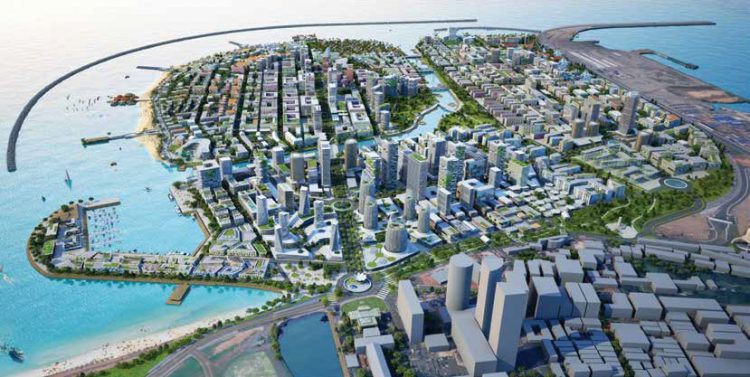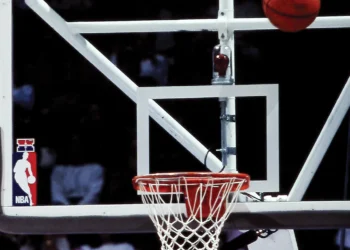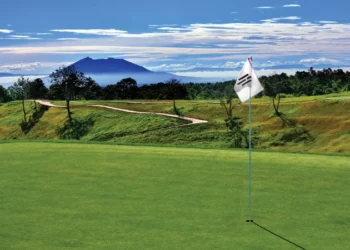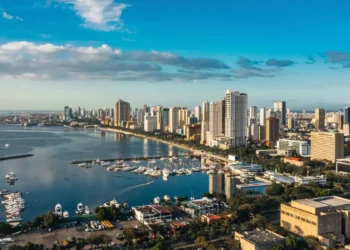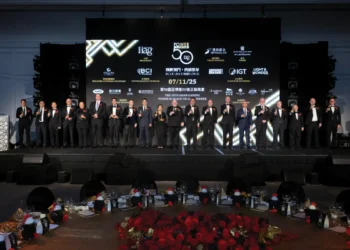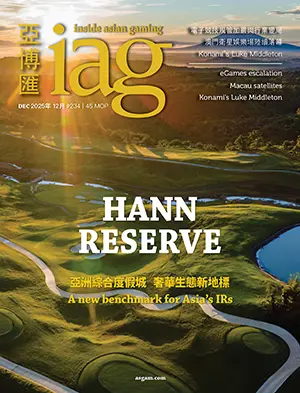Sri Lanka ’s capital of Colombo is being transformed by Chinese-funded infrastructure. The latest and most audacious investment involves a massive land reclamation project to create an ultra-modern extension of the city itself.
These new additions to the skyline, along with the natural wonders and treasured heritage that abound throughout the “Pearl of the Indian Ocean,” as the island nation is known, offer a unique backdrop to the three resort casinos being developed around the city’s master-planned entertainment hub at Beira Lake.
As a package, it certainly seems compelling enough to draw the high-end tourists both the government and the resort developers are after.
In September 2013, it would have taken up to two hours to drive along winding potholed roads to get from Bandaranaike International Airport to Sri Lanka’s capital of Colombo. A month later, the drive time was slashed to 30 minutes with the unveiling of the new US$292 million, 25.8-kilometer-long Colombo-Katunayake Expressway funded by the Export-Import Bank of China. For visitors headed to the Beira Lake district around which the city’s three upcoming casino resorts will be centered, the journey from the airport to a mid-town hotel is now quick and painless.
China is investing big in Sri Lanka—last year it became the leading source of foreign direct investment, supplying 24% of the total $1.42 billion recorded, with Hong Kong providing another 12%. Chinese President Xi Jinping visited the country in September, and while he was there inaugurated Sri Lanka’s biggest electricity generator, a Chinese-funded $1.3 billion, 900-megawatt coal power plant which enabled President Mahinda Rajapaksa to slash citizens’ electricity tariffs by 25% with immediate effect, a move tailor-made to score him populist points ahead of provincial council elections that same month and his own run for a third term in early 2015.
Also during his visit, President Xi launched the construction of the Chinese-financed $1.4 billion Colombo Port City, the largest ever foreignfunded investment in Sri Lanka. The Port City is being built alongside an already existing Chinese-built mega-port by a unit of state-controlled China Communications Construction Co. on 233 hectares of reclaimed land, an area slightly larger than Monaco. The offices, hotels, apartments and shopping centers that will occupy the Port City are expected to draw as much as $20 billion in investment over 15 years, according to Sri Lanka Ports Authority Chairman Priyath Wickrama.
“The government wants to convert Sri Lanka into a maritime center,” he explains. “We can give some competition to Singapore and Dubai, which are running out of capacity.”
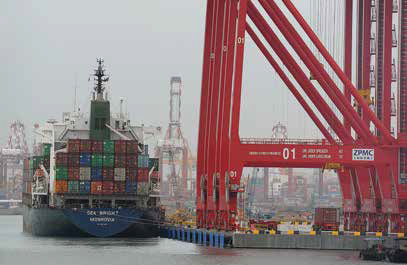
As part of the deal China will gain ownership of one-third of the reclamation area.
At the unveiling, Mr Wickrama diplomatically underplayed the threat to India’s ports, asserting that Indian exporters could in fact benefit from the project.
“Earlier, Indians along the east coast had to send their cargo to Singapore if they wanted to catch a mega-ship going West. Now these mega-ships will be going through Colombo and picking up Indian cargo,” he said. “That saves time and a lot of money.”
COMMITTED SUITORS
For 26 years, the Sri Lankan government was largely consumed with putting down an armed rebellion by ethnic Hindu Tamils in the north of the country. It was a time “when many other countries were reluctant to invest,” as Deputy Minister for Economic Development Lakshman Yapa Abeywardene recalls. But China not only continued pouring money into the country, it insured its investment in the regime by supplying it arms and aid to eventually prevail against the insurgents, which it finally did in the spring of 2009.
“China, clearly, was the decisive factor in ending the war,” as Forbes has noted, and has been a “key factor” five years on in the government’s efforts to deal with the aftermath, “providing Colombo the diplomatic cover against the institution of a U.N. investigation into possible war crimes, or the appointment of a U.N. special envoy on Sri Lanka. In return for such support, Beijing has been able to make strategic inroads into a critically located country in India’s backyard.”
Whatever injustices might have been perpetrated in the final days of the civil war, there seems to be a genuine desire among both Tamils and the predominantly Buddhist Sinhalese majority to put that long and regrettable episode behind them and begin the process of healing.
In his international bestseller “Breakout Nations — In Pursuit of the Next Economic Miracles,” Morgan Stanley’s head of emerging markets, Ruchir Sharma, not only challenges the accepted wisdom that China’s economy will motor on ad infinitum, but he picks 10 economies that look positioned to significantly outpace their peers in economic growth and development over the next decade. Sri Lanka ranks highly among them.
Mr Sharma points out that even during the civil war the economy grew at an average pace of nearly 5%.
“With the nation whole again, achieving a 7% to 8% growth rate over the next decade should be well within reach,” he reckons.
“It would be a mistake to sugarcoat the post-war mood,” he warns. “There is evidence that Tamils, embittered by the bloody end game of the war and suspicious of Rajapaksa, continue to leave the country. But many of those who remain seem determined to put the war memories behind them.”
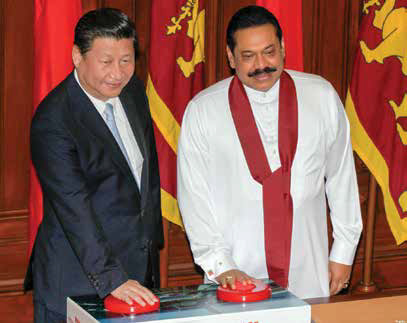
Moreover, he says, “The reintegration of the marginalized Tamils—with their high levels of educational achievement and English fluency—should provide a huge boost to a nation that multiple consulting firms already rank highly as a potential destination for multinationals looking to outsource customer service, IT and other back-office operations.”
Tourism is playing an important role as well, and here, too, the China factor is significant. In 2009, the year before the civil war ended, visitor arrivals totaled around 438,000. In 2013, they surged to more than 1.2 million. And it’s the Chinese who are contributing most to the growth on a percentage basis, with the number of arrivals from China approaching 95,000 through the first nine months of 2014, a jump of 141% over the same period last year. The government has set a target of 1.5 million tourist arrivals for this year and hopes to attract 2.6 million by 2016 and is counting on a number of high-profile marketing and promotional campaigns within China to help make it happen. The government expects that before the end of this year China will overtake the UK to become the country’s second-largest tourist source market behind India, which will likely retain the top spot, given its proximity and strong social and economic ties.
PLUGGING THE HOTEL GAP
Even before Sri Lanka achieved peace it was one of the world’s leading travel destinations. The “Pearl of the Indian Ocean,” as the island is known, boasts hundreds of miles of beaches, tropical forests, lush, unspoiled highland valleys, stunning waterfalls, 15 national parks, botanical gardens, sprawling plantations where those legendary Ceylon teas are grown, centuries-old temples, ornate colonial-era landmarks, eight UNESCO World Heritage sites, even wild elephants.
What’s lacking, however, are sufficient accommodations to cater to the kind of big-spending tourists the government is after.
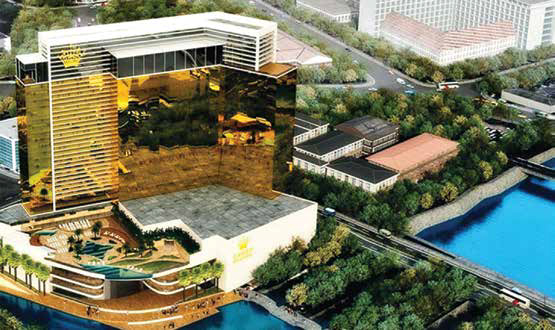
One man on a mission to address this is Dhammika Perera, by many accounts the country’s richest individual and also the biggest casino operator in the country. He began investing in the tourism sector as far back as 2000 and now owns a number of luxury resorts and hotels with 700 rooms in total and another 1,200 in the pipeline. Of the rooms under development, around 500 will be within his US$350 million Queensbury casino resort planned for Beira Lake in Colombo’s tourism core, not far from the US$400 million, 450- room Crown Colombo spearheaded by Australian gaming tycoon James Packer and his local casino partner, Ravi Wijeratne. Plans for the lake area also include an $850 million resort with a casino by the country’s largest publicly traded company, John Keells Holdings, dubbed Waterfront.
The handful of small casinos currently catering to the Colombo tourist trade operated for years as “recreation clubs,” though, as Mr Perera points out, these complied with rules in force since the British colonial era that permitted such clubs to legally operate gaming. After the end of the civil war, the Rajapaksa government got legislation passed to formally recognize the industry by registering the casinos with the Inland Revenue Department for tax purposes. Mr Perera owns three of the four gaming establishments thus officially sanctioned. Mr Wijeratne owns the other. All are located in Colombo, and the biggest, Mr Perera’s Bally’s, has 80 table games (his Bellagio has 40 and his MGM Colombo another 40). Though small in size compared to the super-resorts of Macau and Las Vegas, all are pleasantly decorated and well-maintained and offer service on a par with international standards.
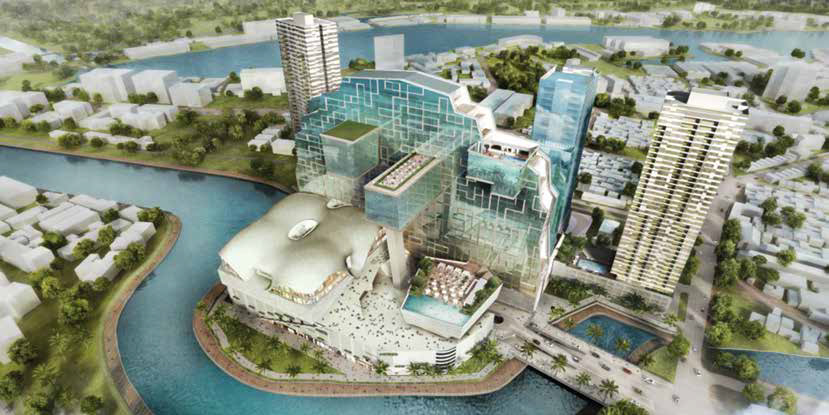
Mr Perera got his start in the gaming industry in 1987 with a slot machine assembling plant. “Then every week there were machines we couldn’t sell, so we started operating them on a rental basis,” he explains.
Then slot machines were banned from 1991 to 1993 during a period of emergency rule established to cope with the Tamil insurgency. When it ended, “We started up the casinos,” Mr Perera says, “but without the machines. That’s how we’ve come to have our current three properties that contain mainly tables and relatively few slots.”
Of his foreign casino clientele, “The Indians and Chinese dominate, each making up about 40%,” he says. “Then 4% are locals, and the balance is other nations.”
He notes the rate of growth rate of the Chinese coming into Sri Lanka, terming it “huge,” and says, “China will rank quite heavily, and of course, with the new properties we expect to bring more tourists, including from the Middle East.”
He does not, however, expect the Chinese market will overtake the Indian. Rather he believes they will remain about the same. Of the three planned resorts, John Keells’ Waterfront is the only one under construction. But the government is mindful of political and religious opposition to new casino licenses and isn’t issuing any, and that means Mr Perera holds the license for Waterfront’s casino. The terms of this arrangement have yet to be concluded, but current plans call for his MGM Colombo to be shut down when Waterfront opens and its license transferred there.
“We have a mutual understanding, then we will finalize the legal binding probably after another three or four months,” he says. “Basically, we will hold the license, and we will formulate a methodology to come together. They will be providing the property, but will not handle operations and infrastructure on the front end of the building, but more on the service and back end.”
The Queensbury’s design is still being fine-tuned under Michael Hong, lead designer of Las Vegas Strip icon Bellagio, and is expected to offer multiple ballrooms, a mini-convention center and a shopping mall in addition to the casino and luxury hotel.
“It will take at least another six months to commit to the final proposal,” says Mr Perera, who takes a keen interest in architecture and design and has a big say in the final look of all his properties.
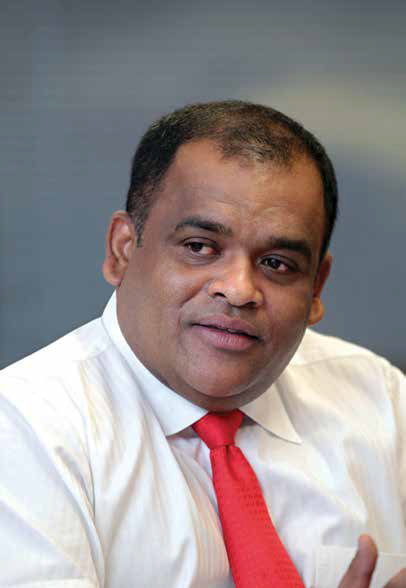
For now, all he’s revealing is that “It will be a nice surprise, incorporating luxury and local motifs—we want to create something lasting for the area.”
He expects construction will take three years and the resort will open about six months later, at which point his Bellagio will have to close so its license can be transferred to the Queensbury. Bally’s, which is currently being expanded, will continue in operation, “but we’re looking for an international operator for it,” he says.
Crown is targeting a 2018 opening for Crown Colombo, but Mr Perera believes it will proceed at a similar pace as Queensbury.
“They also have to finalize their drawing, then build,” he notes. “The two projects, Queensbury and Crown, will probably come at the same time. But John Keells will come before that.”
While working on the Queensbury Mr Perera continues upgrading his existing properties with renovations and extensions and ongoing improvements in service.
“In terms of our staff, we’ve geared ourselves to serve the international market as well as the competition that will come in in light of Crown and probably another international operator that’s going to come into John Keells,” he says. “The last 14 to 15 months have been spent improving everything to come up to that level.
” He has also been busy forming relationships with junket operators and international marketers from China and India to bring high rollers to his properties. “So they’re not only bringing these players into Sri Lanka, but they’ll also bring them into other jurisdictions,” he notes, “so for us to plug into that network that we have now developed and we continue developing, it’s an ongoing thing, we can easily utilize that.”
In this regard, Mr Perera is actively searching for gaming opportunities beyond Sri Lanka. Certainly his pockets are deep enough for that purpose. The 46-year-old’s empire boasts 23 listed entities that account for 8% of all companies traded on the Colombo Stock Exchange, as well as dozens of private ones. His reach extends to Thailand, Indonesia, Japan, even as far the UK, and his companies employ some 62,000 people.
Obviously, gaming is only a small part of the portfolio at this point, last year accounting for about 4% of the revenues of his holding company, Vallibel One.
“Maybe we’ll go up to 6% [with the opening of Queensbury], but we’re looking to acquire some international properties,” he says. “Not just in Asia, we’re open for the world.”
His gaming team is built on a foundation of experienced, loyal casino managers and supervisors who during their tenures with him have often worked under highly challenging conditions. They’ve even managed to pull off the deft feat of getting Chinese and Indians to play comfortably together at the same tables despite the seemingly unbridgeable divide between their styles of gambling. The Indians are prone to drink and socialize at the tables, often smiling, even while losing, whereas for the Chinese gambling tends to be a deadly serious affair full of rituals which in baccarat include diligently looking for patterns in the outcomes of past hands that they believe can foretell the next winning hand.
Interestingly, not only do the two groups mingle harmoniously at Mr Perera’s casinos, each appears to be influenced by the other. The Chinese seem more relaxed and chatty than in Macau, and the Indians—known more for playing roulette and blackjack—have cultivated a considerable interest in baccarat, including tracking outcomes in search of patterns.
Getting Indians to gamble may not seem like much of an achievement—they’re a nation of passionate gamblers—but Macau’s experience proves there’s definitely an art to it. Indian visitors are flocking to Macau, mainly to The Venetian, which has established a high profile in the country through its hosting of Bollywood awards ceremonies that are televised in India and other targeted events and promotions. Despite their numbers, though, the city’s casinos have consistently failed to generate any significant gaming revenue out of them. And it’s not as if tiny Macau—unlike Sri Lanka—offers a wealth of things to see and do outside its casinos. It has given rise to the assumption among operators, generally speaking, that Indians just aren’t that interested in gambling. Mr Perera and his team know better. “We handle quite a big number of Indians already,” he points out. “We know how to deal with them. We can bring them to other places also.”






